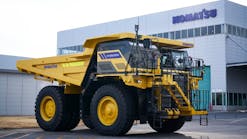Although injectors showed sign of scuffing—the result of hard-particle contamination, which, says the report, “is the greatest fuel-quality concern for high-pressure/common-rail fuel systems, worldwide”—investigators determined that scuffing was not the primary issue for the immediate problems the bus engines were exhibiting.
The culprits in this instance were “metal carboxylates” in the fuel, more commonly know as “diesel soaps.” The recommended fix for the problem was use of a fuel additive that could both clean the injectors and minimize further deposits, coupled with much tighter filtration.
Another Bad Actor: Glycerin
Biofuel is manufactured by reacting a plant-derived fat or oil (usually soybeans in the United States) with an alcohol, using sodium hydroxide as a catalyst. An unwanted by-product of the process is glycerin. Although most of the glycerin is washed out during the manufacturing process, regulations do allow 200 ppm to remain.
Biofuel usually is mixed with petroleum diesel in 5-, 10- or 20-percent concentrations to form biofuel blends, but even at these relatively low concentrations, enough glycerin remains to create filter-plugging problems when, under certain fuel moisture and temperatures conditions, it becomes a solid and drops out of solution.
To help counteract glycerin’s effects, Jim Peterson, sales manager for Donaldson’s Hydraulics and Clean Solutions Group, suggests these measures:
- Filter fuel on the dispensing side of the bulk tank and use proper on-machine filters
- Keep fuel dry with proper tank flushing and proper breathers
- If possible, moderate the temperature of stored fuel above the glycerin dropout level
- Turn over fuel as quickly as possible
- Keep fuel infrastructure as free from particulate contamination as possible
- Ask OEMs about using detergent additives to keep glycerin in solution, both in equipment and bulk storage
Although problems with diesel soaps are far from epidemic (and some would say are of lesser concern now than several years ago), the presence of these contaminants in diesel fuel is a definite concern among some fleet managers.
For example, Leigh Dennis, CEM—manager of fleet services for Carolina Sunrock, a Raleigh-based supplier of concrete products and contracting services—was puzzled by the short life of bulk dispensing filters, which, when visually inspected, showed little evidence of typical filter-plugging debris, such as particulates, asphaltenes or microbial contamination. Dennis had the filters analyzed by Donaldson Filtration Solutions, and excerpts from the resulting 12-page report tell the story:
“In order to determine the cause of the filter plugging, the following tests were performed: GC-MS, FT-IR, LCMS and EDS methods and imaged by SEM….The primary contaminant observed on the filter was carboxylate-related chemistry.”
Potential problems caused by diesel soaps include rapid plugging of high-efficiency fuel filters and injector deposits that can lead to eventual injector failure.
Although fuel-injector designs vary, some being more robust than others, the moving components in some designs (compared with previous designs) lack the mass and momentum to overcome the gumming effect of soaps, says John Cummins, vice president of technology, Hydrotex, a lubricant- and fuel-management company and additive manufacturer. The result, he says, is that injectors today can be more susceptible to deposits.
“Injectors today are designed for multiple injections in a single combustion cycle,” says Cummins, “and if the action is sluggish, the injector will not perform precisely—fuel economy suffers and emissions increase.”
Along the way, injector deposits can result in poor engine performance, degraded fuel economy and, as evidenced by the New York City bus fleet, serious over-fueling issues that might cause turbocharger problems and dilute engine oil. The latter, among other detriments, can drop the viscosity of oil significantly and jeopardize the film thickness on critical components, dilute the concentration of oil additives, and wash down oil on the cylinder walls.
How diesel soaps are made
Cliff Burbrink, chemical technology specialist at Cummins Filtration, provides a layman’s definition of diesel soaps:
“Diesel soap is not very different chemically than the soap used to wash your hands. The main ingredient in a bar of soap is formed when lye reacts with fats or oils. Lye is sodium hydroxide. Fats and oils contain fatty acids. When they react, they form sodium soaps. Diesel soaps are formed from acidic additives in the fuel [such as some corrosion inhibitors and lubricity improvers] reacting with trace amounts of sodium.”
Rick Chapman, Industry & OEM Liaison Manager, Innospec Fuel Specialties, adds that acids can be derived also from other sources: “[Soaps] can also be formed from free fatty acids in biodiesel starting materials and carboxylic acids derived from oxidatively degraded fuel and/or biodiesel.”
From a layman’s point of view, then, the formation of diesel soaps is the result of metals, such as sodium, calcium and potassium (in the form of positively charged ions, or cations), reacting with various sources of acid in the fuel.
“When these two species [acidic compounds and cations (usually sodium)] come together, diesel soap can form,” says Chapman. “There are a lot of other factors or variables that can play into it, of course, such as pH, solubility, mixing intensity and so forth—but this is the basis for it. Unfortunately, when these soaps form, assuming they are formed from additives, they make the corrosion inhibitor or lubricity improver inert, and the corrosion or lubricity protection provided by the additive is lost.”
Speculation about metal sources
Some fuel experts are of the opinion that the problem with diesel soaps started showing up with the introduction of ultra-low-sulfur diesel fuel (ULSD) and the nearly coincident practice of blending biofuel into petroleum diesel, biofuel being a plant-derived alternative fuel—usually soybeans in the United States.
Some speculate that since sulfur and other compounds contribute lubricity to diesel fuel, its removal necessitated the addition of a greater volume of lubricity-improver additives, contributing to the acid side of the soap equation. (Chapman adds that lubricity improvers were mandated in October 2004, well before ULSD.)
Also, since sulfur is a biocide that helps mitigate microbial growth that can form corrosive acids, further speculation is that some refiners introduced added corrosion inhibitors to take up the slack for the missing sulfur, and in the process, contributed further to the acid side of the soap equation.
On the other side of the equation, the metal side, some say that since the manufacture of biofuel necessitates the use of caustic washes, often containing sodium, the washing process can contribute the metal ions needed to produce soaps.
“Biofuel is manufactured with different catalysts,” says Hydrotex’s Cummins, “which can be sodium- or potassium-based. Potentially, the processes can contribute to different soaps.”
Most of the time, these processes are very well controlled, says Innospec Fuel Specialties’ Chapman, referring to caustic washes used to neutralize acid-type processes. But some carryover into the fuel is possible, he says, and on occasion, “excursions” of such caustics as sodium hydroxide can enter the fuel.
“There appear to be a lot more cations, such as sodium and calcium, in the distribution system today than before ultra-low-sulfur diesel came along,” says Chapman, “but to be objective, the problem really wasn’t studied before the proposed link to the injector-plugging issue. Still, we were surprised to see how much [of these metals] was in water-bottom samples and tank samples after low-sulfur was introduced. Usually, where you see increased use of biofuel blends, you also see increased sodium in water bottoms.”
Although fuel experts disagree about whether conductivity additives (which reduce the prospect of static-electricity buildup as fuel moves through its delivery infrastructure)—or whether the presence in pipelines of water containing calcium ions—contribute to the soap problem, some are of the opinion that they do.
Filtration and additives
As noted before, the contamination of diesel fuel with soaps is not as prevalent, at least in many fleets, as other sources of fuel contamination, including hard particulates, increased water in biofuel blends, rapid oxidation of such blends, microbial growth, so-called asphaltenes (compounds that can agglomerate into an oily sludge), acetic acid formation and glycerin, the latter an unwanted by-product of biofuel manufacturing.
“There are so many inherent problems with diesel fuel today,” says Hydrotex’s Cummins, “that machine owners must take a holistic approach when attempting to resolve them.”
The best defense against diesel soaps (and for most other contaminants, as well) seems to be the use of premium filtration (tank intake, tank dispensing, and on-machine), good tank housekeeping, and a well-chosen additive package. Additives might be included in “premium” diesel fuel offered by some jobbers, but solving a serious soap problem might require consultation with an additive supplier who can take a comprehensive, laboratory-assisted view of all the fuel-quality issues in a particular fleet.
But the best efforts are no guarantee of complete success when dealing with diesel soaps.
“We’ve seen soap deposits form in engines that use our most effective filters—those proved to remove 99.9 percent of material 4 microns and larger and significant amounts of material smaller than 4 microns,” says Cummins Filtration’s Burbrink. “If soap particles don’t agglomerate before the filter, they can pass through it. When they hit the injectors, the heat can cause these particles to deposit on metal.”
Same with deposit-control additives: “We have seen great success with some additives,” says Burbrink. “The use of good detergents has dropped the failure rate significantly in some applications. Unfortunately, we also have seen customers having issues even though they are using detergents.”
That said, a well-formulated additive package seems to be an integral part of the potential resolution of problems with diesel soaps. A good, multi-functional package will contain corrosion inhibitors and lubricity improvers (some formulations use non-acid, non-reacting lubricity improvers), as well as a deposit-control agent that will assist in cleaning injectors and minimizing further deposits.
“The key to diminishing field issues is the use of a two-prong strategy,” says Innospec’s Chapman. “One, use an additive that provides the required lubricity but is resistant to reaction with metal hydroxides, and, two, use a deposit-control additive to ‘clean up’ and ‘keep clean’ any deposits that may form, regardless of the their source. Deposit-control additives are useful for reducing injector deposits, reducing filter plugging, and for carrying through trace amounts of water. In lower-dose rates, or at a ‘keep-clean’ level, they will put a protective coating on metal surfaces and not allow deposits to form—or will limit their formation.”
Hydrotex’s Cummins makes the point, too, that treatment rates for additives, a corrosion inhibitor, for example, might have to be adjusted to meet the conditions of a particular storage tank.
Cummins also reminds machine owners that deposit-control additives might need time to work in certain situations: “Soap deposits can get very deep into the injectors, become sticky, and cause poor actuation of the pintle. A good additive package will help clean the injectors, but given the nature of the deposits, it’s usually not a quick fix. The process might require four or five tanks of treated fuel before improvement is noticed.”
Sunrock’s Dennis offers this suggestion to fellow fleet managers: “I would recommend that fleet managers, if they haven’t already done so, educate their fuel suppliers on the subject of upstream fuel-contamination issues and their effects on diesel engines. Managers can use that opportunity to register their concerns about diesel soaps—for the purpose of promoting a partnership in utilizing countermeasures against diesel-fuel contamination. Their fleet reliability depends on it.”





